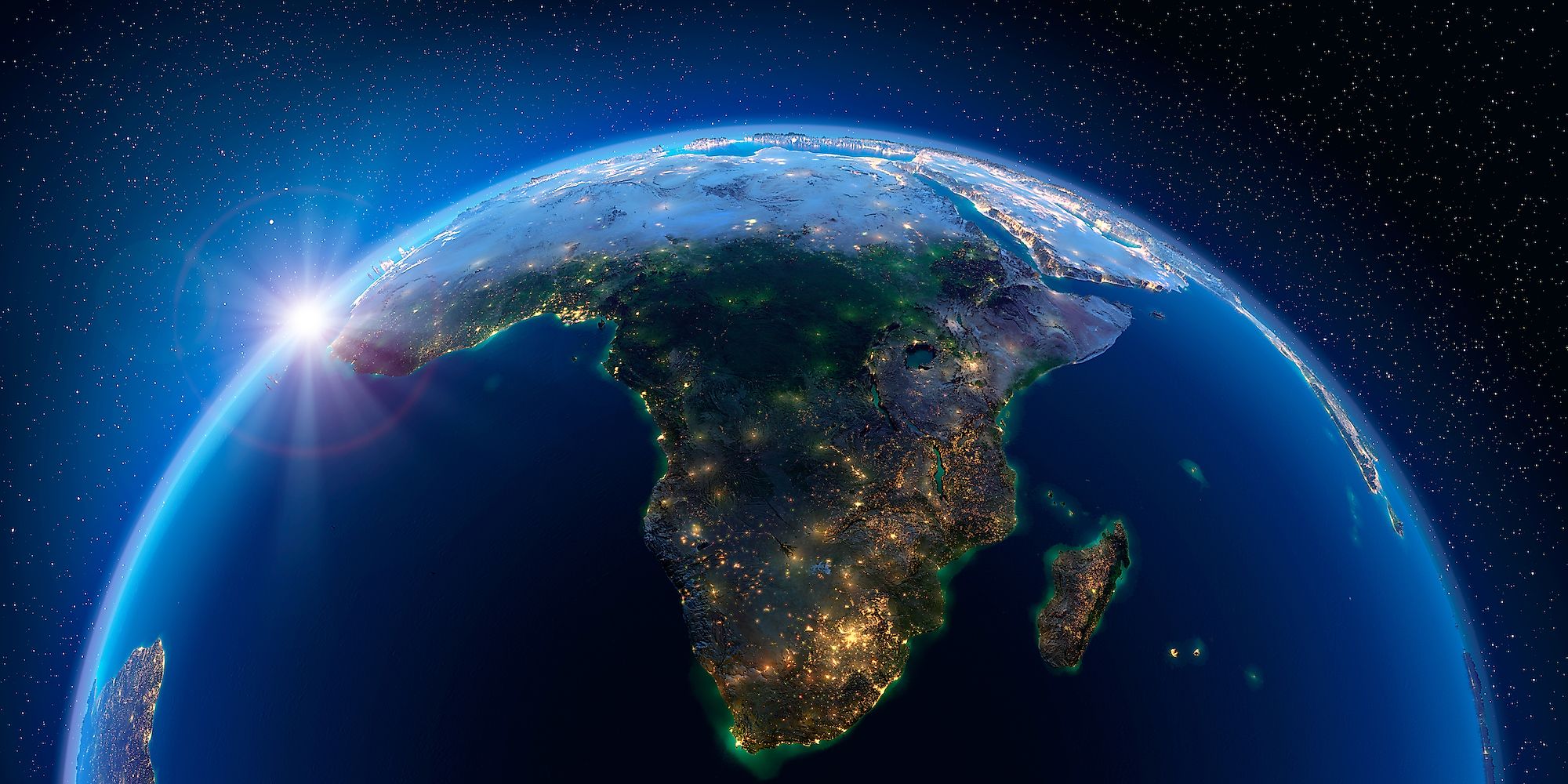
African Countries By Population
Africa is the world’s second-largest continent by both population and size. It covers approximately 30.37 million square kilometers and is home to about 1.3 billion people, or 16% of the global population. Its population is four times that of the United States and slightly less than China’s population.
Africa has an average population density of 45 people per square kilometer. However, the population and population density range across the 54 countries, with Nigeria as Africa’s most populous country and Seychelles as the least populous country. Mauritius is the most densely populated country, while Namibia is the most sparsely populated nation.
Approximately 1.1 billion people or 85% of the African population live within the Sub-Saharan Region (a region south of Northern Africa). Africa is one of the fastest-growing regions, with its population surpassing Europe in the 1990s and Americas in the 2000. The continent’s population is expected to overtake that of India and China by 2022. With a population growth rate of about 2%, Africa’s population is projected to reach over 4 billion by 2100.
Top 10 African Countries By Population
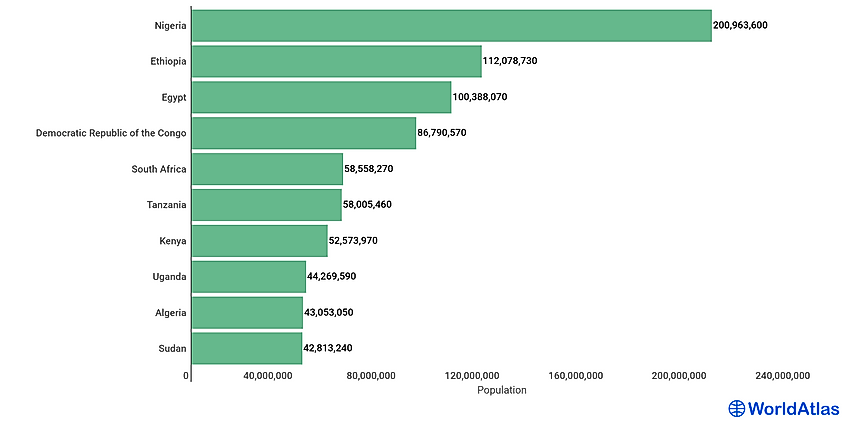
About 799.5 million people in Africa or 61.5% of the continent’s population live in ten countries. Africa’s top ten most populous countries are distributed across the four regions; Eastern, Northern, Central, and Southern Africa, with five of the ten countries located within the Eastern Africa region.
Nigeria is Africa’s most populous country, with about 201 million people. The West African country accounts for about 15.5% of the African population. It is also the world’s 6th most populous country, accounting for about 3% of the global population. Nigeria’s population is about two-thirds that of the US.
Ethiopia, located on the horn of Africa, is the continent’s second-most populous country, with 112.1 million people. Its population is slightly more than half of Nigeria’s population despite it being significantly larger than Nigeria by total area. Ethiopia accounts for 8.6% of Africa’s and 1.4% of the global population.
Egypt is North Africa’s largest country and Africa’s third-largest by population, with 100.4 million people or 7.7% of the continent’s population. It is the world’s 14th most-populous country, accounting for 1.3% of the global population.
Although the Democratic Republic of the Congo is Africa’s second-largest country by size, it is the continent’s 4th most-populous country with 86.8 million people (6.7%). The DRC’s population is one of the fastest-growing populations in the world, increasing from 47 million in 2000 to the current 86.7 million.
South Africa and Tanzania have almost equal populations, with the southern African country having a slight edge over Tanzania. South Africa is home to 58.5 million people or 4.5% of Africans, while Tanzania hosts 58 million people or 4.46% of the continent’s population. However, Tanzania’s population is expected to surpass South Africa’s before 2030.
Kenya and Uganda, the two East African neighbors, are the 7th and 8th most populous countries respectively. Kenya is home to 52.3 million people, or 4% of the continent’s population. Uganda, which is 2.5 times smaller than Kenya, has a population of 44.3 million people, or 3.4% of Africa’s population. It is the 8th densely populated country in Africa, with 213 people per square kilometer.
Algeria is North Africa’s second-most populous country after Egypt. With a population of 43.1 million people, it is Africa’s 9th most populous country. Algeria is Africa’s largest country and one of the most sparsely populated countries in the Arab World. Sudan, Africa’s second-largest country after Algeria, is the 10th most populous country in the continent, with 42.8 million people. It accounts for about 3.3% of Africa’s population.
Bottom 5 African Countries By Population
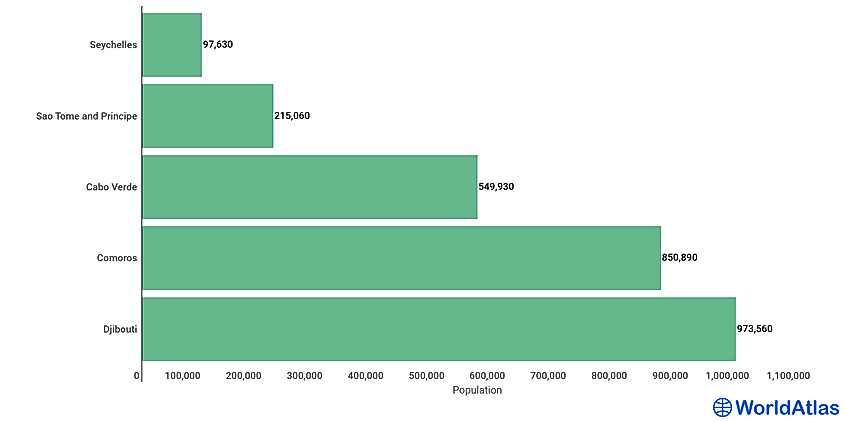
Africa’s five least populous countries have a combined population of approximately 2.7 million. The five countries collectively account for 0.2% of total Africa’s population. All the five countries, except Djibouti, are island nations and some of Africa’s smallest countries by size.
Seychelles, an island nation in the Indian Ocean, is Africa’s smallest country by both size and population. It covers an area of about 451 square kilometers and has a population of 97,625 people, representing less than 0.1% of the continent’s population. Sao Tome and Principe is Africa’s second-smallest country by population and size. The two islands cover approximately 964 square kilometers and are home to some 215,000 people.
Cape Verde is the third smallest country by population, hosting about 550,000 people. It is Africa’s 5th smallest country by area, covering 4,033 square kilometers. Comoros, another island country in the Indian Ocean, is Africa’s 4th smallest country, with about 851,000 people. Djibouti is the least populated country in mainland Africa and the continent’s 5th least populated country, with about 974,000 people. Although Djibouti is a small country, it is over ten times larger than Comoros, which has about 120,000 fewer people. Djibouti’s lower population is partly due to its arid nature and poverty problem.
5 Most Densely And 5 Most Sparsely Populated African Countries
Most Central and Northern African countries are sparsely populated, with the majority recording at most 25 people per square kilometers. Eastern, Central, and Western Africa are the densely populated countries in the region. Mauritius, a tiny island country east of Madagascar in the Indian Ocean, is Africa’s most crowded country and the world’s 10th densely populated country, with 623 people per square kilometers. It covers an area of approximately 2,040 square kilometers but is home to 1.3 million people.
Rwanda, a country in Eastern Africa, covers an area of about 26,798 square kilometers and is home to 12.8 million people. With a population density of 499 people per square kilometers, it is Africa’s second-most densely populated country and the world’s 14th most-crowded country. Although Comoros is Africa’s 4th smallest country by population, with about 851,000 people, it is the continent’s 3rd and world’s 16th most-densely populated country, with 447 people per square kilometers.
Burundi and The Gambia are the 4th and 5th most densely populated countries in Africa, with 435 and 225 people per square kilometer. Burundi covers an area of approximately 27,830 square kilometers and has a population of 11.5 million people, while The Gambia’s 2.3 million people are spread across 10,380 square kilometers.
Namibia is Africa’s most sparsely populated country, with 3 people per square kilometer. Although it is the continent’s 15th largest country, covering 825,418 square kilometers, it is Sub-Sahara’s driest country. Thus, the low population density is because of the country’s arid nature.
Libya, Botswana, and Mauritania have population densities of 4 people per square kilometers, making them Africa’s second-most sparsely populated country. Libya is Africa’s 4th largest country by area, covering 1.76 million square kilometers. However, it has a population of only 6.8 million people, with over 80% of the people living in urban areas. Most parts of the country are dry and lack infrastructure, making them uninhabitable. About 70% of Botswana is within the Kalahari Desert, while 90% of Mauritania is in the Sahara Desert, making them sparsely populated countries.
Although the Central African Republic has an area of 622,984 square kilometers, it has a population of 3.8 million people, making it one of Africa’s most sparsely populated countries. The high poverty levels and ongoing wars are responsible for CAR’s low population and population density.
5 Most Populous African Countries By 2100
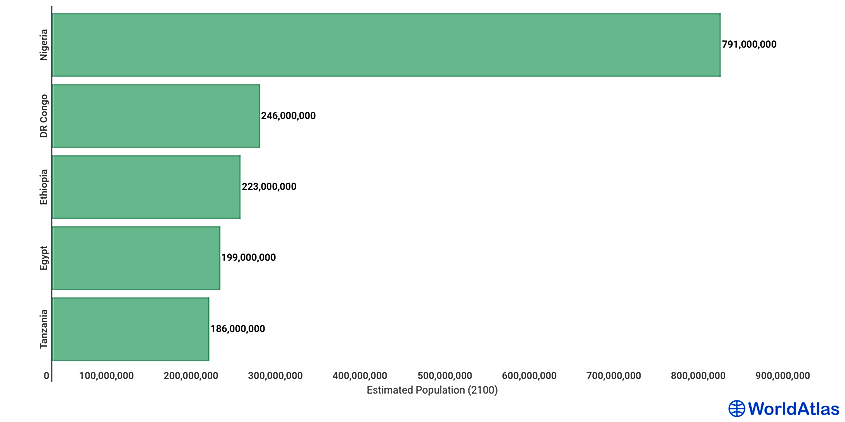
Africa has one of the world’s fastest-growing populations. In 1950, the continent had only 177 million people. However, within seven decades, grew over 7.5 times to the current 1.3 billion people. The population surpassed the one billion mark in 2009. An increase in life expectancy and a decrease in infant mortality rates are the main factors that contributed to the exponential growth.
Demographers expect Africa’s population to continue growing. Most countries will maintain a growth rate of over 2% at least until the end of the 21st century. Africa is projected to have 4-5 billion people by 2100. Western and Eastern Africa countries will account for about 70% of the continent’s population.
Although Asia has some of the most populous countries globally, with 5 of the ten populous countries located in the region, the population outlook will change by 2100. Five African countries are expected to be among the world’s ten most populous countries. Nigeria is expected to remain Africa’s largest country but move up the world’s ranking to third after China and India, with 791 million people. The DRC will be Africa’s second-most and world’s 6th most populous country, with 246 million people. Ethiopia (223 million), and Egypt (199 million), and Tanzania (186 million) will also feature on the list of the top ten largest countries.
54 African Countries By Population
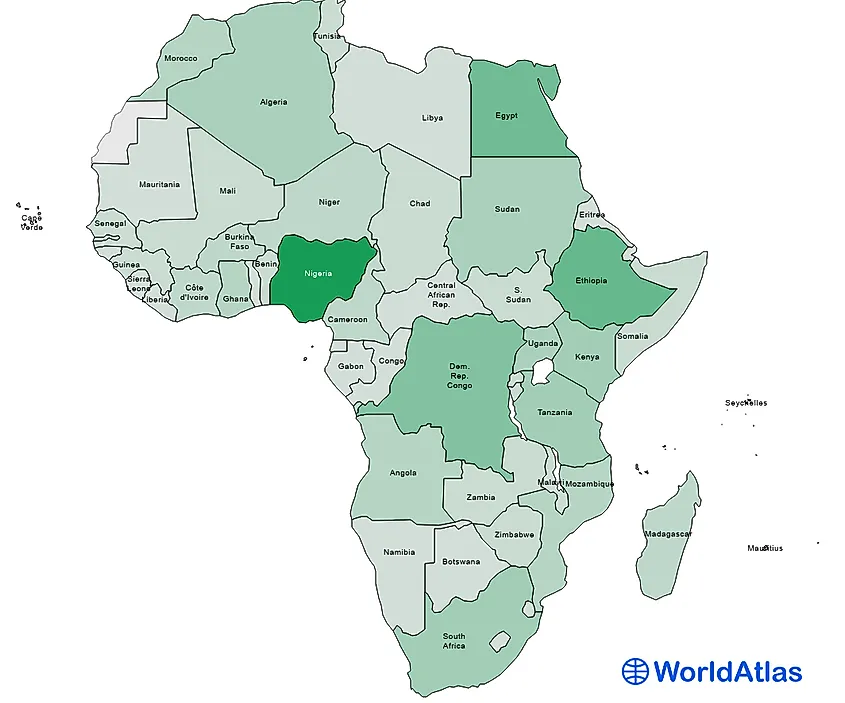
|
Rank |
Country Name |
Population |
|---|---|---|
|
1 |
Nigeria |
200,963,600 |
|
2 |
Ethiopia |
112,078,730 |
|
3 |
Egypt |
100,388,070 |
|
4 |
Democratic Republic of the Congo |
86,790,570 |
|
5 |
South Africa |
58,558,270 |
|
6 |
Tanzania |
58,005,460 |
|
7 |
Kenya |
52,573,970 |
|
8 |
Uganda |
44,269,590 |
|
9 |
Algeria |
43,053,050 |
|
10 |
Sudan |
42,813,240 |
|
11 |
Morocco |
36,471,769 |
|
12 |
Angola |
31,825,290 |
|
13 |
Ghana |
30,417,860 |
|
14 |
Mozambique |
30,366,040 |
|
15 |
Madagascar |
26,969,310 |
|
16 |
Cameroon |
25,876,380 |
|
17 |
Cote d'Ivoire |
25,716,540 |
|
18 |
Niger |
23,310,720 |
|
19 |
Burkina Faso |
20,321,380 |
|
20 |
Mali |
19,658,030 |
|
21 |
Malawi |
18,628,747 |
|
22 |
Zambia |
17,861,030 |
|
23 |
Senegal |
16,296,360 |
|
24 |
Chad |
15,946,880 |
|
25 |
Somalia |
15,442,910 |
|
26 |
Zimbabwe |
14,645,470 |
|
27 |
Guinea |
12,771,250 |
|
28 |
Rwanda |
12,626,950 |
|
29 |
Benin |
11,801,150 |
|
30 |
Tunisia |
11,694,720 |
|
31 |
Burundi |
11,530,580 |
|
32 |
South Sudan |
11,062,110 |
|
33 |
Togo |
8,082,370 |
|
34 |
Sierra Leone |
7,813,220 |
|
35 |
Libya |
6,777,450 |
|
36 |
Congo |
5,380,510 |
|
37 |
Liberia |
4,937,370 |
|
38 |
Central African Republic |
4,745,190 |
|
39 |
Mauritania |
4,525,700 |
|
40 |
Eritrea |
3,213,970 |
|
41 |
Namibia |
2,494,530 |
|
42 |
The Gambia |
2,347,710 |
|
43 |
Botswana |
2,303,700 |
|
44 |
Gabon |
2,172,580 |
|
45 |
Lesotho |
2,125,270 |
|
46 |
Guinea-Bissau |
1,920,920 |
|
47 |
Equatorial Guinea |
1,355,990 |
|
48 |
Mauritius |
1,265,710 |
|
49 |
Eswatini |
1,148,130 |
|
50 |
Djibouti |
973,560 |
|
51 |
Comoros |
850,890 |
|
52 |
Cabo Verde |
549,930 |
|
53 |
Sao Tome and Principe |
215,060 |
|
54 |
Seychelles |
97,630 |
|
55 |
Total |
1,306,033,387 |
Table: African countries by population. Source: World Bank











